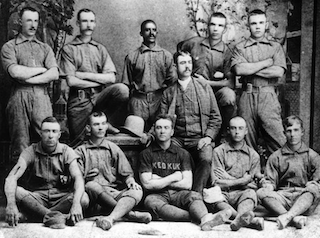
Sept/Oct 2022 (Volume 14, Issue 5)
By Michael Swanger
If you watched the televised 2022 National Baseball Hall of Fame Induction Ceremony in Cooperstown, N.Y. on July 24, you might have heard Hall of Famer Dave Winfield’s speech about John W. Jackson, a.k.a. Bud Fowler, the first African American player to integrate professional teams and that the 12-time All-Star played for the Keokuk Hawkeyes.

Bud Fowler (back row, third from left), played for the Keokuk Hawkeyes in 1885 and left an indelible mark on history as the first Black player in professional baseball. Photo courtesy of National Baseball Hall of Fame and Museum
Fowler, who was a pitcher for 16 years and second baseman for 12 years, played for several teams during the late 19th and early 20th centuries before the game’s color line was officially drawn — though racism ran rampant in the game. He was one of seven baseball legends — alongside Gil Hodges, Jim Kaat, Minnie Miñoso, Tony Oliva, Buck O’Neil and David Ortiz — to have been inducted into the National Baseball Hall of Fame in July. He was born in Fort Plain, N.Y., on March 16, 1858, before his family moved to Cooperstown a few years later … the town in which his Hall of Fame plaque now resides at the National Baseball Hall of Fame.
“The color of Fowler’s skin forced him into a more nomadic career than his white contemporaries,” reads Fowler’s biography on the National Baseball Hall of Fame’s website. “He manned second base for the Keokuk Hawkeyes in Iowa, appeared in the Colorado State League, signed with the Topeka Capitals, returned east to star for the Binghamton Crickets, ventured to Indiana to play for the Terre Haute Hoosiers, traveled Southwest to join the New Mexico League, represented Greenville in the Michigan State League and led the Nebraska State League in steals. All told, historians estimate he played for more than a dozen leagues throughout the course of his career, while Fowler himself claimed to have played on teams ‘based in twenty-two different states and in Canada.’”
Fowler’s stint with the Keokuk Hawkeyes in 1885 was brief. He played with them for only eight games before the team collapsed when the Western League dissolved on June 29, 1885, only one year after the Keokuks organized themselves and entered the league as a AA team. After the league folded, the team barnstormed for a month. Fowler is pictured with the team and the photograph is popular among baseball historians.
During those eight games with Keokuk, the 27-year-old Fowler — who threw and hit right-handed and stood 5’7” and weighed 155 pounds — hit .222 in his 36 plate appearances. Many of Fowler’s statistics were never recorded or lost over the years during his playing years from 1878 to 1895.
“In 1894, Fowler teamed up with Grant ‘Home Run’ Johnson to form the Page Fence Giants, who would go on to become one of the all-time great Black barnstorming teams,” according to the National Baseball Hall of Fame. “It was during the team’s inaugural season that Fowler faced off against a major league team when the Page Fence Giants took on the Cincinnati Reds in a two-game exhibition match-up. They lost against the Reds, but the season proved to be a success — particularly for Fowler himself, who hit .316 on the year. Later on, he had a hand in establishing other barnstorming clubs, including the Smoky City Giants, All-American Black Tourists and the Kansas City Stars, and was a strong proponent of establishing Black baseball leagues.”
Fowler returned to New York following his baseball career where he died on Feb. 26, 1913.
IHJ back issues on sale
Iowa History Journal’s annual sale of 50 percent off our collectible back issues and posters during September and October is a great time to complete your collection of Iowa History Journal.
Iowa History Journal is now in its 14th year of publishing and most of our back issues are on sale for only $2.50. Limited quantities of many of our most popular issues, including those featuring John Wayne, Buffalo Bill, Sullivan Brothers, Iowa caucuses and Buddy Holly remain. Our first two years, 2009 and 2010, are sold out and only a handful of two issues from 2011 remain (Meredith Wilson and Lou Hoover).
Visit iowahistoryjournal.com and select “Previous Issues” for a summary of each issue’s editorial content, then visit our online store, or call us at (515) 490-7325, to purchase them. See the back cover of this issue for a sample of back issues that are on sale.
TO READ MORE FASCINATING STORIES ABOUT IOWA HISTORY, subscribe to Iowa History Journal. You can also purchase back issues at the store.
